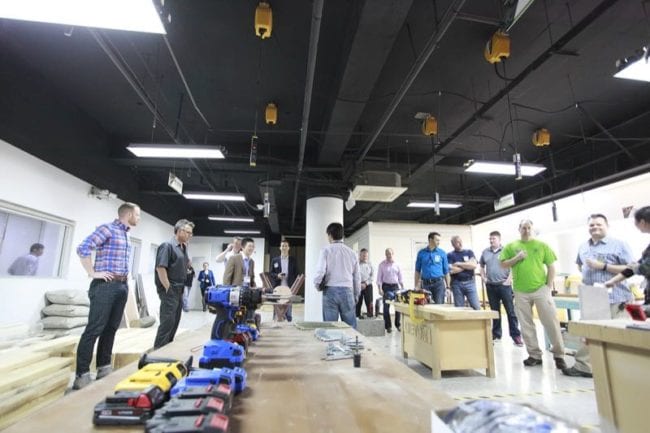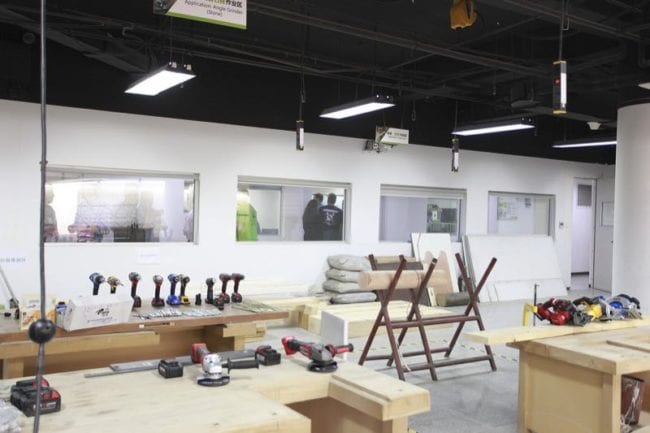After we got an introduction to the history of Chervon manufacturing, we got even more exposure to the workings of the company behind such brands as EGO cordless power tools and Flex. This came in the form of a Chervon Research and Development Lab Tour. The Chervon R&D lab was built back in 2007 and it serves as the primary research and testing ground for their EGO line as well as most of their OEM and ODM products.
It may surprise you to know that EGO manufactures quite a lot of saws and laser tools, including some very popular benchtop glide miter saws you may have used (or at least heard of) over the years. Chervon was also one of the leading manufacturers in the world to release cordless lithium ion power tools—their exposure to cordless power tools goes way back to the beginning, and they are running right beside the other experts in the field of maximizing the capabilities of high current lithium-ion cordless technology.
Chervon began manufacturing tools back in 1997 and achieved various qualifications from most major certification bodies in domestic China as well as international and third party organizations like UL. They’ve progress so far in capabilities that UL has allowed them to test onsite through their CTDP (Client Test Data Program) certification program (Chervon is CTDP certified for power tool testing). This lets them certify tools for UL standards onsite without needing to have UL witness their testing. This is a very advanced certification that saves time while maintaining the same quality of UL standards.
Some info on the UL Client Test Data Program
Investigations of products by UL typically involve the testing of product samples. While UL maintains extensive facilities for these purposes, customers can also utilize their own testing facilities through UL’s Client Test Data Program. UL established the Client Test Data Program to assist customers wanting to use their own testing facilities. More info
Starting Our Chervon Research and Development Lab Tour
Our Chervon Research and Development Lab tour took us through a myriad of rooms where we were able to witness a lot of how Chervon performs R&D on their power tools. While we aren;t going to give away any trade secrets, it’s informative to know just how much work goes into designing, producing, and testing corded and cordless power tools. Here’s a brief overview of just some of the rooms and facilities we were able to visit:
Construction Checking Room
This is the first step in a safety certification process so Chervon engineers test electrical and mechanical stress. We saw them testing cable integrity by flexing it over 20,000 times. For electrical stress testing they used electric shock and dialectic testing. Mechanical drop tests include 1 meter drops onto different surfaces like wood and concrete. They test corded tools in various receptacles and can test input output, voltage spikes and more.
Chemical Testing Lab
European directives dictate that environmental friendly chemicals are used, so Chervon must test their materials to ensure and demonstrate they are using the right materials that don’t violate these standards. By using advanced tools to test atomic absorption, gas spectrography, and more, they can perform these verifications and monitor exactly what is going into plastics and metals being used in the manufacturing process. For example, a UV spectrophotometer can test corrosion-protective coatings, and they can perform various other tests to check the composition of plastics and rubberized materials.
Material Testing Room
This room tests the performance of plastics. They have a hot wire test that applies a 200 amp wire onto the plastic surface of a tool to test flammability. This allows the engineers to observe whether it can ignite at all. If it does, they monitor how long it will burn. For another test they check conductivity and metal properties as well as how tools and materials hold up against various temperatures and humidity. It’s one thing for a tool to work when it comes off the assembly line—ensuring it will work on an actual joist is an entirely different matter that requires testing. For even more rigorous testing of this nature, we moved onto the next room.
Environmental Testing Room
In the environmental testing room Chervon used large machines that can actually house entire tools and test different working conditions and temperatures up to 150 degrees or down to 40 degrees. They also use these machines to test the corrosion properties of the various metals used in their tools and run them in environments of up to 98% humidity…that’s almost as much humidity as you get in the Florida summer—they’ll need to ratchet it up to 99-100% to top our worst days! Of course, another waterproof testing room actually used a multidirectional spray nozzle system to test lawn mowers when being hit by water from all directions.
Comparative Testing
They use a Skidmore Wilhelm torque tester similar to the one we used in our 18V cordless impact driver shootout to verify and compare the torque of various brushless impact drivers. They can also test how the different batteries affect power output and torque. For example, 1P batteries are 1.5 or 2Ah packs while a 2P battery pack is a two layer parallel battery of 3.2 or 4.0 Ah. The biggest difference in power output between these batteries comes when the amp draw ramps up under load.
Another tool was used to test the clutch of an OEM product by repeatedly rotating it back and forth for thousands of cycles. They also do a PTI torque testing setup which we could appreciate since it’s an agreed upon method used by all major power tool manufacturers.
Overload Testing Room
The overload testing room makes sure the normal working conditions can be maintained even with higher voltage conditions without fear of fire or electrical fault to the user. Basically they get to overload and underload the tools with a variac variable autotransformer and see how well the tool handles it. If any room we saw during the Chervon Research and Development Lab tour was important to Floridians (who experience a lot of power fluctuations due to storms and other events), this was it!
EMC Testing Room
EMC certification is a mandatory requirement in Europe, and it’s similar to the American FCC. EMC stands for electromagnetic compatibility. This tests EMF and EFI interference so that a power tool doesn’t affect any devices outside of itself. A large room is used which includes a length of cable used to simulate the antenna which would pick up any electrical interference. This didn’t look like a particularly fun job to have at the Chervon Research and Development lab, but it’s certainly essential.
DC Tools (Battery Testing) Room
Imagine an entire room dedicated to simply testing and verifying battery pack compatibility between tools and chargers. The Chervon Research and Development lab also tests the charge rate and uses additional environmental chambers to ensure the usability of the batteries in various extreme working conditions (for example, they test batteries to well below freezing).
When they do these tests they also test the battery’s cycle life under these various conditions. That means that they combine a high discharge rate with various temperatures and conditions to see how well the various packs hold up.
Practical Use Testing Room
Testing tools using machines and equipment is one thing, but practical testing is also essential (and informative). This room uses machines to simulate real world use and tests tools like saws and rotary hammers for vibration testing as well as performance testing. Two machines were literally slamming trimmers and blowers against the wall and floor. A new EGO 56V backpack blower was being manhandled by a machine that was tethered to its control arm. In another area, an EGO hedge trimmer was repeatedly cutting through what looked like 3/8″ wood dowels. The third room eliminated the machine testing altogether and had real people testing circular saws, angle grinders, and more on various materials.
Across the hall testing of saws and drills was occurring—with various tools being lined up and connected to machines that measured the speed/RPMs while running them nonstop to verify life cycles.
Still another room had people drilling…and drilling… They were drilling holes through lumber and sinking lag bolts into 2×8 boards. Other stations had them testing various tools using sheet metal.
Towards the end of our Chervon Research and Development Lab tour we got to see the new EGO 56V snow blower blowing through and endless pile of damp sawdust that had turned brown like coffee grounds after the amount of use it was put through. The snow blower was on a proprietary machine that allowed them to test the tool almost indefinitely for run-time and performance. It was an ingenious rig.
Mechanical Strength Testing Room
In one of our final rooms, Chervon tested tools like their lawnmowers against very aggressive situations. As an example, they had various sizes of steel ball bearings on the floor, and the new EGO self propelled cordless lawn mower would be tested while the steel balls were sent into the spinning blade. Looking at the door you could see the practical results of the testing—it was littered with divots and holes from wild flying steel balls. Somehow I think our resident Safety Third specialist, David C. Smith, would have a field day in this room.
Conclusion
Checking out the Chervon Research and Development lab was a great experience. We’ve now seen several of these facilities, and Chervon is right up there with the other power tool manufacturers we’ve seen in terms of how they test and the thoroughness of their methodologies. They used impressive equipment, had innovative solutions to common problems, and showed us that the longevity and durability of their tools was something they took seriously—as evidenced by the rigorous procedures each tool has to go through to pass certification.






